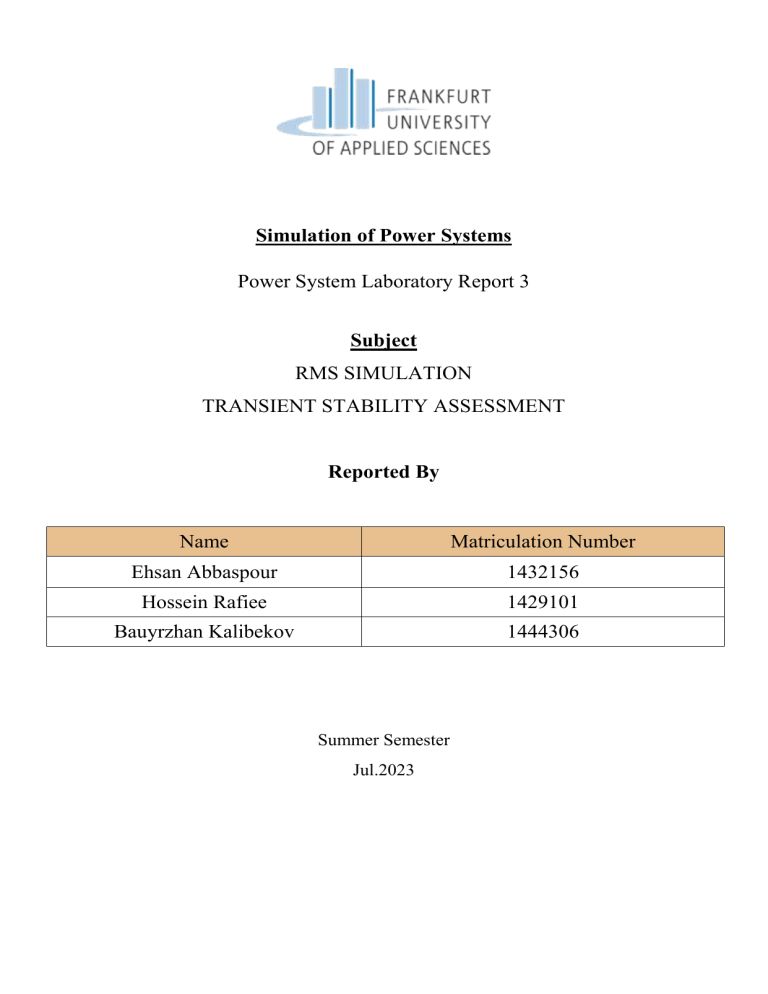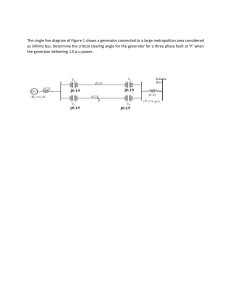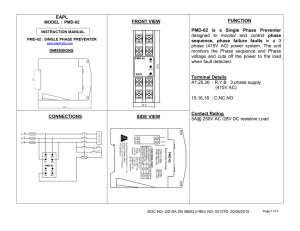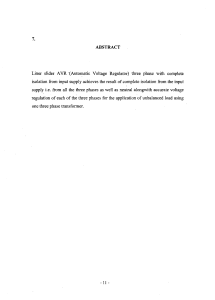
Simulation of Power Systems Power System Laboratory Report 3 Subject RMS SIMULATION TRANSIENT STABILITY ASSESSMENT Reported By Name Matriculation Number Ehsan Abbaspour 1432156 Hossein Rafiee 1429101 Bauyrzhan Kalibekov 1444306 Summer Semester Jul.2023 First Part: Simple-Machine Infinite Bus (SMIB) 1. The infinite bus is the reference bus of the system. Perform a load flow. How much is the series current through the circuit? 2. Remember during the class, we have discussed that with the results of the power flow, it is possible to calculate the internal voltages of the generators. Select the RMS simulation and calculate the initial conditions by using the command “Calculation command” and analyze the system in the prefault condition. 3. Now define the events affecting the stability of the power system. Simulate a three phase balanced fault at 0,1 sec at one of the lines. Clear the fault 0,1 sec later. Fault impedance is zero. Show the graphs for the speed of the generator, the excitation voltage, rotor angle deviation and the bus voltage. Conclude. 4. Increase the fault duration to 500ms. With regards to the obtained 4 graphs explain the impact of the fault clearing time. 5. Let the fault clearing time again be 100ms. Decrease the distance to the synchronous machine. Let the fault be very close to the high voltage site of the transformer. Let the short circuit of the line be 90% to the site of the high voltage bus. Describe the impact of the fault location with regards to the system stability. Distance 90 percent (near the generator) Second Part: excitation system 6. Let the fault location be again in the middle of the line. Implement the AVR IEEET1 for the synchronous machine. You find the AVR under DIGSILENT library-> dynamic models -> PSSE-compatible. Obtain the graphs for the speed of the generator, the excitation voltage and rotor angle deviation and the voltage of the bus. Compare the results with the results under exercise 4. IGNORED # 7. The measurement delay of the AVR will be neglected with immediate response. Change the gain of the controller, the exciter and the feedback. Compare your results with regards to the voltage of the bus. a) Taking into consideration the overshoot of the voltage, what would the ideal parameters of the AVR look like? b) What would the parameters of the AVR have to look like if you want to achieve the fastest settling time? Third Part 8. Use the IEEE 9 bus system (Figure 2). This system was introduced in the book Power System Control and Stability by P. M. Anderson and A. A. Fouad [2]. The system contains 9 buses, 3 generators, 3 loads, 6 transmission lines and 3 transformers representing a simplified transmission network. Perform a load flow and calculate the initial conditions. Analyze the system in the prefault condition. 9. Simulate a three phase balanced fault at the terminal of each generator at time 0,7 sec. The fault is cleared at the time 0.8 sec. Increase the fault clearing time to 0.3s. Calculate the settling time. For which case does the generator take longer to stabilize? Show the graphs for the speed of each generator, the excitation voltage and rotor angle deviation. Conclude. 10.Simulate a three phase balanced fault on line 5‐7. Introduce the fault at the time 0,1 sec and clear the fault after 100ms. Show the graphs for the speed of each generator, the excitation voltage and rotor angle deviation. Describe what happens with the rotor angles of the machines. Compare the graphs to the last exercise with regards to the rotor angles. 11.Integrate the automatic voltage controller IEEET1 for the generator 2. Generator 1 and generator 3 does not contain any gov and AVR model to keep the system simple for analysis. Simulate a three-phase balanced fault on line 5‐7. Introduce the fault at the time 0,1 second and clear the fault after 100ms. Show the graphs for the speed of each generator, the excitation voltage, the rotor angle deviation of the machine 2, the terminal voltage, current and active and reactive power of the positive sequence. 12.Other three random AVR models have been chosen from the library named as IEEE T3, IEEE T5 and EXAC4. Compare the performance of the AVR models regarding the rotor angle stability. Did the AVRs maintain the required voltage profile? Add the graphs. 13.The best excitation system depends upon the operating conditions, power system requirements and economic aspects. Taking into consideration ONLY the transient behavior and the settling time of all AVR models, what would be your choice?




